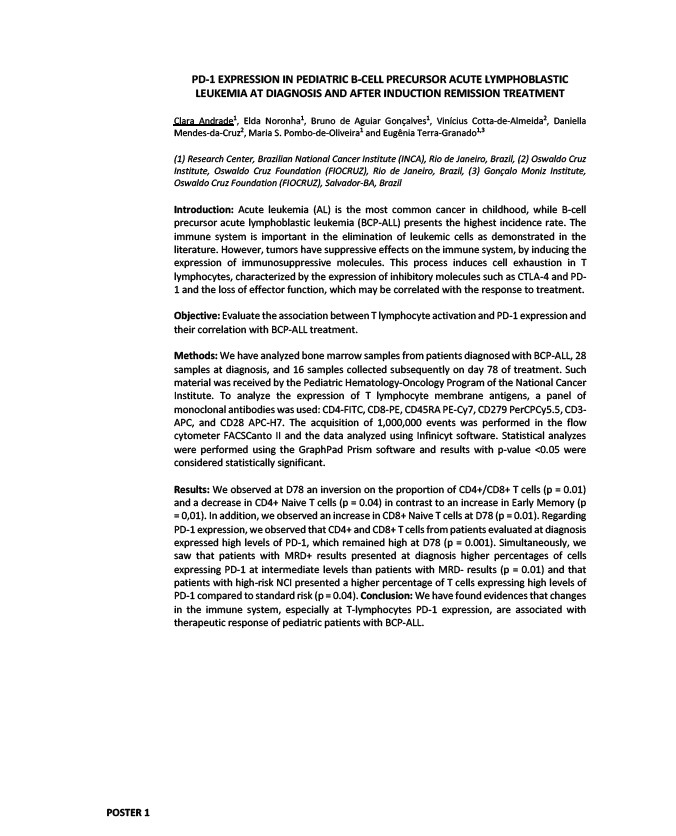
PD-1 EXPRESSION IN PEDIATRIC B-CELL PRECURSOR ACUTE LYMPHOBLASTIC
LEUKEMIA AT DIAGNOSIS AND AFTER INDUCTION REMISSION TREATMENT
Clara Andrade1, Elda Noronha1, Bruno de Aguiar Gonçalves1, Vinícius Cotta-de-Almeida2, Daniella
Mendes-da-Cruz2, Maria S. Pombo-de-Oliveira1 and Eugênia Terra-Granado1,3
(1) Research Center, Brazilian National Cancer Institute (INCA), Rio de Janeiro, Brazil, (2) Oswaldo Cruz
Institute, Oswaldo Cruz Foundation (FIOCRUZ), Rio de Janeiro, Brazil, (3) Gonçalo Moniz Institute,
Oswaldo Cruz Foundation (FIOCRUZ), Salvador-BA, Brazil
I
ntroduction: Acute leukemia (AL) is the most common cancer in childhood, while B-cell
precursor acute lymphoblastic leukemia (BCP-ALL) presents the highest incidence rate. The
immune system is important in the elimination of leukemic cells as demonstrated in the
literature. However, tumors have suppressive effects on the immune system, by inducing the
expression of immunosuppressive molecules. This process induces cell exhaustion in T
lymphocytes, characterized by the expression of inhibitory molecules such as CTLA-4 and PD-
1 and the loss of effector function, which may be correlated with the response to treatment.
Objective: Evaluate the association between T lymphocyte activation and PD-1 expression and
their correlation with BCP-ALL treatment.
Methods: We have analyzed bone marrow samples from patients diagnosed with BCP-ALL, 28
samples at diagnosis, and 16 samples collected subsequently on day 78 of treatment. Such
material was received by the Pediatric Hematology-Oncology Program of the National Cancer
Institute. To analyze the expression of T lymphocyte membrane antigens, a panel of
monoclonal antibodies was used: CD4-FITC, CD8-PE, CD45RA PE-Cy7, CD279 PerCPCy5.5, CD3-
APC, and CD28 APC-H7. The acquisition of 1,000,000 events was performed in the flow
cytometer FACSCanto II and the data analyzed using Infinicyt software. Statistical analyzes
were performed using the GraphPad Prism software and results with p-value <0.05 were
considered statistically significant.
Results: We observed at D78 an inversion on the proportion of CD4+/CD8+ T cells (p = 0.01)
and a decrease in CD4+ Naive T cells (p = 0.04) in contrast to an increase in Early Memory (p
= 0,01). In addition, we observed an increase in CD8+ Naive T cells at D78 (p = 0.01). Regarding
PD-1 expression, we observed that CD4+ and CD8+ T cells from patients evaluated at diagnosis
expressed high levels of PD-1, which remained high at D78 (p = 0.001). Simultaneously, we
saw that patients with MRD+ results presented at diagnosis higher percentages of cells
expressing PD-1 at intermediate levels than patients with MRD- results (p = 0.01) and that
patients with high-risk NCI presented a higher percentage of T cells expressing high levels of
PD-1 compared to standard risk (p = 0.04). Conclusion: We have found evidences that changes
in the immune system, especially at T-lymphocytes PD-1 expression, are associated with
therapeutic response of pediatric patients with BCP-ALL.
POSTER 1